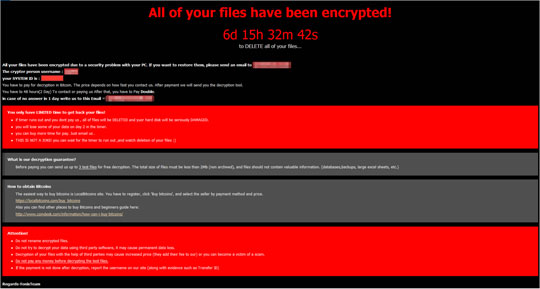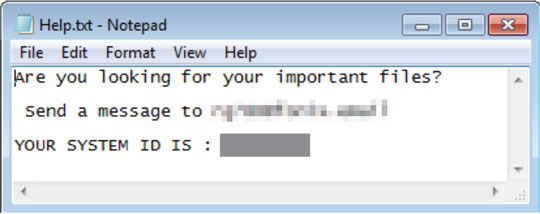Ransom.Win64.FONIX.B
Trojan-Dropper.Win32.Dapato.qhjg (KASPERSKY)
Windows


Threat Type: Ransomware
Destructiveness: No
Encrypted: No
In the wild: Yes
OVERVIEW
This Ransomware arrives on a system as a file dropped by other malware or as a file downloaded unknowingly by users when visiting malicious sites.
It adds certain registry entries to disable the Task Manager. This action prevents users from terminating the malware process, which can usually be done via the Task Manager.
It drops files as ransom note.
TECHNICAL DETAILS
Arrival Details
This Ransomware arrives on a system as a file dropped by other malware or as a file downloaded unknowingly by users when visiting malicious sites.
Installation
This Ransomware adds the following folders:
- %User Temp%\IXP000.TMP
(Note: %User Temp% is the current user's Temp folder, which is usually C:\Documents and Settings\{user name}\Local Settings\Temp on Windows 2000(32-bit), XP, and Server 2003(32-bit), or C:\Users\{user name}\AppData\Local\Temp on Windows Vista, 7, 8, 8.1, 2008(64-bit), 2012(64-bit) and 10(64-bit).)
It drops the following files:
- %User Temp%\IXP000.TMP\XINOF.exe
- %User Temp%\IXP000.TMP\SystemScheduler.exe
- %User Temp%\IXP000.TMP\Cpriv.key
- %User Temp%\IXP000.TMP\Cpub.key
- %User Temp%\IXP000.TMP\SystemID
- %User Temp%\IXP000.TMP\Help.txt
- %User Temp%\Cpriv.key
- %User Temp%\Cpub.key
- %ProgramData%\Cpriv.key
- %ProgramData%\Cpub.key
- %ProgramData%\CrptSrvcFLG
- %ProgramData%\SystemID
- %ProgramData%\Help.txt
- %ProgramData%\Hello {Name}
- {Encrypted Directory}\Cpriv.key
(Note: %User Temp% is the current user's Temp folder, which is usually C:\Documents and Settings\{user name}\Local Settings\Temp on Windows 2000(32-bit), XP, and Server 2003(32-bit), or C:\Users\{user name}\AppData\Local\Temp on Windows Vista, 7, 8, 8.1, 2008(64-bit), 2012(64-bit) and 10(64-bit).. %ProgramData% is a version of the Program Files folder where any user on a multi-user computer can make changes to programs. This contains application data for all users. This is usually C:\ProgramData on Windows Vista, 7, 8, 8.1, 2008(64-bit), 2012(64-bit) and 10(64-bit), or C:\Documents and Settings\All Users on Windows Server 2003(32-bit), 2000(32-bit) and XP.)
It adds the following processes:
- %System%\cmd.exe /c schtasks /CREATE /SC ONLOGON /TN fonix /TR %ProgramData%\XINOF.exe /RU SYSTEM /RL HIGHEST /F
- %System%\cmd.exe /c copy XINOF.exe %appdata%\Microsoft\Windows\Start Menu\Programs\Startup\XINOF.exe
- %System%\cmd.exe /c attrib +h +s %User Startup%\XINOF.exe
- %System%\cmd.exe /c reg add HKEY_LOCAL_MACHINE\SOFTWARE\Microsoft\Windows\CurrentVersion\Run\ /v "PhoenixTechnology" /t REG_SZ /d %ProgramData%\XINOF.exe /f
- %System%\cmd.exe /c reg add HKEY_CURRENT_USER\SOFTWARE\Microsoft\Windows\CurrentVersion\Run\ /v "PhoenixTechnology" /t REG_SZ /d %ProgramData%\XINOF.exe /f
- %System%\cmd.exe /c reg add HKEY_LOCAL_MACHINE\SOFTWARE\Microsoft\Windows\CurrentVersion\RunOnce\ /v "PhoenixTechnology" /t REG_SZ /d %ProgramData%\XINOF.exe /f
- %System%\cmd.exe /c reg add HKEY_CURRENT_USER\SOFTWARE\Microsoft\Windows\CurrentVersion\RunOnce\ /v "PhoenixTechnology" /t REG_SZ /d %ProgramData%\XINOF.exe /f
- %System%\cmd.exe /c reg add HKEY_LOCAL_MACHINE\Software\Microsoft\Windows\CurrentVersion\Policies\System /v DisableTaskMgr /t REG_DWORD /d 1 /f
- %System%\cmd.exe /c reg add HKEY_CURRENT_USER\Software\Microsoft\Windows\CurrentVersion\Policies\System /v DisableTaskMgr /t REG_DWORD /d 1 /f
- %System%\cmd.exe /c reg add "HKEY_LOCAL_MACHINE\SOFTWARE\Policies\Microsoft\Windows Defender" /v DisableAntiSpyware /t REG_DWORD /d 1 /f
- %System%\cmd.exe /c reg delete HKEY_CURRENT_USER\System\CurrentControlSet\Control\SafeBoot /va /F
- %System%\cmd.exe /c reg delete HKEY_LOCAL_MACHINE\System\CurrentControlSet\Control\SafeBoot /va /F
- %System%\cmd.exe /c reg add "HKEY_LOCAL_MACHINE\SOFTWARE\Policies\Microsoft\Windows\System" /v AllowBlockingAppsAtShutdown /t REG_DWORD /d 1 /f
- %System%\cmd.exe /c reg add "HKEY_CURRENT_USER\Software\Microsoft\Windows\CurrentVersion\Policies\Explorer" /v NoClose /t REG_DWORD /d 1 /f
- %System%\cmd.exe /c reg add "HKEY_CURRENT_USER\Software\Microsoft\Windows\CurrentVersion\Policies\Explorer" /v StartMenuLogOff /t REG_DWORD /d 1 /f
- %System%\cmd.exe /c icacls * /grant Everyone:(OI)(CI)F /T /C /Q
- %System%\cmd.exe /c Copy Cpriv.key %ProgramData%\Cpriv.key
- %System%\cmd.exe /c Copy Cpub.key %ProgramData%\Cpub.key
- %System%\cmd.exe /c Copy SystemID %ProgramData%\SystemID
(Note: %ProgramData% is a version of the Program Files folder where any user on a multi-user computer can make changes to programs. This contains application data for all users. This is usually C:\ProgramData on Windows Vista, 7, 8, 8.1, 2008(64-bit), 2012(64-bit) and 10(64-bit), or C:\Documents and Settings\All Users on Windows Server 2003(32-bit), 2000(32-bit) and XP.. %User Startup% is the current user's Startup folder, which is usually C:\Windows\Profiles\{user name}\Start Menu\Programs\Startup on Windows 98 and ME, C:\WINNT\Profiles\{user name}\Start Menu\Programs\Startup on Windows NT, C:\Documents and Settings\{User name}\Start Menu\Programs\Startup on Windows 2003(32-bit), XP and 2000(32-bit), or C:\Users\{user name}\AppData\Roaming\Microsoft\Windows\Start Menu\Programs\Startup on Windows Vista, 7, 8, 8.1, 2008(64-bit), 2012(64-bit), 10(64-bit).)
It adds the following mutexes to ensure that only one of its copies runs at any one time:
- FakeMutex
- FonixCryptServiceMUTEX
Autostart Technique
This Ransomware adds the following registry entries to enable its automatic execution at every system startup:
HKEY_LOCAL_MACHINE\SOFTWARE\Microsoft\
Windows\CurrentVersion\Run
PhoenixTechnology = %ProgramData%\XINOF.exe
HKEY_CURRENT_USER\SOFTWARE\Microsoft\
Windows\CurrentVersion\Run
PhoenixTechnology = %ProgramData%\XINOF.exe
HKEY_LOCAL_MACHINE\SOFTWARE\Microsoft\
Windows\CurrentVersion\RunOnce
PhoenixTechnology = %ProgramData%\XINOF.exe
HKEY_CURRENT_USER\SOFTWARE\Microsoft\
Windows\CurrentVersion\RunOnce
PhoenixTechnology = %ProgramData%\XINOF.exe
It drops the following file(s) in the Windows User Startup folder to enable its automatic execution at every system startup:
- %User Startup%\XINOF.exe
(Note: %User Startup% is the current user's Startup folder, which is usually C:\Windows\Profiles\{user name}\Start Menu\Programs\Startup on Windows 98 and ME, C:\WINNT\Profiles\{user name}\Start Menu\Programs\Startup on Windows NT, C:\Documents and Settings\{User name}\Start Menu\Programs\Startup on Windows 2003(32-bit), XP and 2000(32-bit), or C:\Users\{user name}\AppData\Roaming\Microsoft\Windows\Start Menu\Programs\Startup on Windows Vista, 7, 8, 8.1, 2008(64-bit), 2012(64-bit), 10(64-bit).)
Other System Modifications
This Ransomware adds the following registry entries:
HKEY_LOCAL_MACHINE\SOFTWARE\Policies\
Microsoft\Windows\System
AllowBlockingAppsAtShutdown = 1
HKEY_CURRENT_USER\Software\Microsoft\
Windows\CurrentVersion\Policies\
Explorer
NoClose = 1
HKEY_CURRENT_USER\Software\Microsoft\
Windows\CurrentVersion\Policies\
Explorer
StartMenuLogOff = 1
It adds the following registry entries to disable the Task Manager:
HKEY_LOCAL_MACHINE\Software\Microsoft\
Windows\CurrentVersion\Policies\
System
DisableTaskMgr = 1
HKEY_CURRENT_USER\Software\Microsoft\
Windows\CurrentVersion\Policies\
System
DisableTaskMgr = 1
It creates the following registry entry(ies) to bypass Windows Firewall:
HKEY_LOCAL_MACHINE\SOFTWARE\Policies\
Microsoft\Windows Defender
DisableAntiSpyware = 1
It deletes the following registry keys:
HKEY_CURRENT_USER\System\CurrentControlSet\
Control\SafeBoot
HKEY_LOCAL_MACHINE\System\CurrentControlSet\
Control\SafeBoot
File Infection
This Ransomware avoids infecting files that contain the following strings in their names:
- SystemScheduler.exe
- Hello {Name}
- Cpub.key
- Cpriv.ket
- FonixDecrypter.exe
- CrptSrvcFLG
- How To Decrypt.hta
- Help.txt
Process Termination
This Ransomware terminates the following processes if found running in the affected system's memory:
- agntsvc.exe
- dbeng50.exe
- dbsnmp.exe
- encsvc.exe
- endnote.exe
- excel.exe
- filemon.exe
- firefoxconfig.exe
- infopath.exe
- isqlpplussvc.exe
- isqlpussvc.exe
- msaccess.exe
- msftesql.exe
- mspub.exe
- mydesktopqos.exe
- mydesktopservice.exe
- mysqld-nt.exe
- mysqld-opt.exe
- mysqld.exe
- netmon.exe
- notepad++.exe
- notepad.exe
- ntoskrnl.exe
- ocautoupds.exe
- ocomm.exe
- ocssd.exe
- onenote.exe
- oracle.exe
- outlook.exe
- paint.exe
- powerpnt.exe
- procmon.exe
- regmon.exe
- Sandboxiedcomlaunch.exe
- sqbcoreservice.exe
- sqlagent.exe
- sqlbrowser.exe
- sqlservr.exe
- sqlwriter.exe
- Ssms.exe
- stream.exe
- synctime.exe
- taskmgr.exe
- tbirdconfig.exe
- thebat.exe
- thebat64.exe
- Thunderbird.exe.visio.exe
- vboxservice.exe
- vboxtray.exe
- vmtoolsd.exe
- vmwareservice.exe
- vmwareuser.exe
- winword.exe
- wireshark.exe
- wordpad.exe
- xfssvccon.exe
Other Details
This Ransomware adds the following scheduled tasks:
- Task Name: fonix
Trigger: At logon of any user
Action: %ProgramData%\XINOF.exe
(Note: %ProgramData% is a version of the Program Files folder where any user on a multi-user computer can make changes to programs. This contains application data for all users. This is usually C:\ProgramData on Windows Vista, 7, 8, 8.1, 2008(64-bit), 2012(64-bit) and 10(64-bit), or C:\Documents and Settings\All Users on Windows Server 2003(32-bit), 2000(32-bit) and XP.)
Ransomware Routine
This Ransomware appends the following extension to the file name of the encrypted files:
- {Original Filename}.{Original File Extension}.Email=[rg780@fonix.email]ID=[{ID}].XINOF
It drops the following file(s) as ransom note:
- %ProgramData%\How To Decrypt Files.hta
- {Encrypted Directory}\How To Decrypt Files.hta

It leaves text files that serve as ransom notes containing the following text:
- {Encrypted Directory}\Help.txt

SOLUTION
Step 1
Before doing any scans, Windows 7, Windows 8, Windows 8.1, and Windows 10 users must disable System Restore to allow full scanning of their computers.
Step 2
Note that not all files, folders, and registry keys and entries are installed on your computer during this malware's/spyware's/grayware's execution. This may be due to incomplete installation or other operating system conditions. If you do not find the same files/folders/registry information, please proceed to the next step.
Step 3
Restart in Safe Mode
Step 4
Delete this registry value
Important: Editing the Windows Registry incorrectly can lead to irreversible system malfunction. Please do this step only if you know how or you can ask assistance from your system administrator. Else, check this Microsoft article first before modifying your computer's registry.
- In HKEY_LOCAL_MACHINE\SOFTWARE\Microsoft\Windows\CurrentVersion\Run
- PhoenixTechnology = %ProgramData%\XINOF.exe
- PhoenixTechnology = %ProgramData%\XINOF.exe
- In HKEY_CURRENT_USER\SOFTWARE\Microsoft\Windows\CurrentVersion\Run
- PhoenixTechnology = %ProgramData%\XINOF.exe
- PhoenixTechnology = %ProgramData%\XINOF.exe
- In HKEY_LOCAL_MACHINE\SOFTWARE\Microsoft\Windows\CurrentVersion\RunOnce
- PhoenixTechnology = %ProgramData%\XINOF.exe
- PhoenixTechnology = %ProgramData%\XINOF.exe
- In HKEY_CURRENT_USER\SOFTWARE\Microsoft\Windows\CurrentVersion\RunOnce
- PhoenixTechnology = %ProgramData%\XINOF.exe
- PhoenixTechnology = %ProgramData%\XINOF.exe
- In HKEY_LOCAL_MACHINE\Software\Microsoft\Windows\CurrentVersion\Policies\System
- DisableTaskMgr = 1
- DisableTaskMgr = 1
- In HKEY_CURRENT_USER\Software\Microsoft\Windows\CurrentVersion\Policies\System
- DisableTaskMgr = 1
- DisableTaskMgr = 1
- In HKEY_LOCAL_MACHINE\SOFTWARE\Policies\Microsoft\Windows Defender
- DisableAntiSpyware = 1
- DisableAntiSpyware = 1
- In HKEY_LOCAL_MACHINE\SOFTWARE\Policies\Microsoft\Windows\System
- AllowBlockingAppsAtShutdown = 1
- AllowBlockingAppsAtShutdown = 1
- In HKEY_CURRENT_USER\Software\Microsoft\Windows\CurrentVersion\Policies\Explorer
- NoClose = 1
- NoClose = 1
- In HKEY_CURRENT_USER\Software\Microsoft\Windows\CurrentVersion\Policies\Explorer
- StartMenuLogOff = 1
- StartMenuLogOff = 1
Step 5
Search and delete these files
- %User Temp%\IXP000.TMP\XINOF.exe
- %User Temp%\IXP000.TMP\SystemScheduler.exe
- %User Temp%\IXP000.TMP\Cpriv.key
- %User Temp%\IXP000.TMP\Cpub.key
- %User Temp%\IXP000.TMP\SystemID
- %User Temp%\IXP000.TMP\Help.txt
- %User Temp%\Cpriv.key
- %User Temp%\Cpub.key
- %ProgramData%\Cpriv.key
- %ProgramData%\Cpub.key
- %ProgramData%\CrptSrvcFLG
- %ProgramData%\SystemID
- %ProgramData%\Help.txt
- %ProgramData%\Hello {Name}
- %ProgramData%\How To Decrypt Files.hta
- %User Startup%\XINOF.exe
- {Encrypted Directory}\Cpriv.key
- {Encrypted Directory}\Help.txt
- {Encrypted Directory}\How To Decrypt Files.hta
Step 6
Search and delete this folder
- %User Temp%\IXP000.TMP
Step 7
Restart in normal mode and scan your computer with your Trend Micro product for files detected as Ransom.Win64.FONIX.B. If the detected files have already been cleaned, deleted, or quarantined by your Trend Micro product, no further step is required. You may opt to simply delete the quarantined files. Please check this Knowledge Base page for more information.
Step 8
Restore encrypted files from backup.
Did this description help? Tell us how we did.

